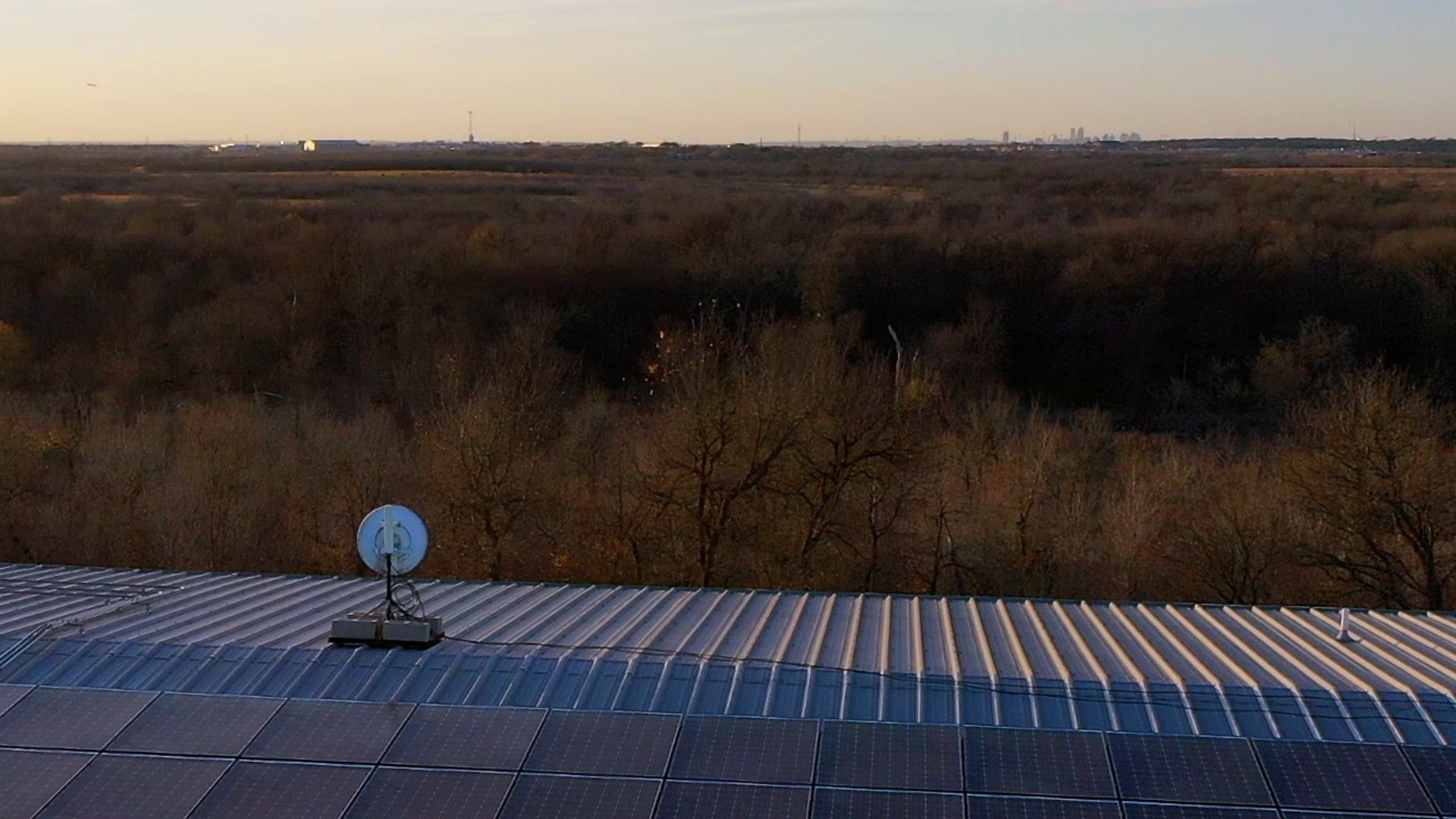'This Community Is A Blind Spot': Del Valle Residents Fall Into Internet Access Gap
Benjamin Covington is getting ready for a job interview. He goes through the usual virtual chat pre-checks, setting up his computer and checking his Wi-Fi connection. But he’s not in a home office or at his kitchen table. Because he can’t access reliable internet at home, Covington is getting ready for this interview outside the Elroy Library, sitting at a picnic table under a sheet metal awning.
“This was a more reasonable solution,” Covington says. “It’s really shocking that we’re so close to a tech hub and that we’re having to come sit outside a library just to be able to do basic internet stuff.”
The Elroy Library is situated just south of Circuit of The Americas. For many residents like Benjamin Covington, the Wi-Fi here is the most reliable means of getting online.
In Del Valle, about 3,000 residents have a single option or no option for an internet service provider. How residents get online, and how much it will cost, greatly depends on where someone lives. It’s especially difficult for those living outside of subdivisions and off the main roads, like Covington. Some are often left cobbling together their own solutions that can cost significantly more, while others just remain unplugged.
“It surprised me that this is the level of internet I see in a first world country,” Covington says.
Cathy Olive lives just east of Circuit of The Americas. A cable runs into her house providing a physical connection to the internet. It’s what the Federal Communications Commission defines as broadband internet because she has a constant connection with a minimum speed of 25 megabits per second. This should be fast enough for someone to work from home, but experts like Michael Ward Jr., president and CEO of Austin Urban Technology Movement (AUTMHQ), disagree.
“They can’t have a job working from their home … with 25 megabits per second if they're on their computer at the same time as their child is also on [for] school,” Ward says. “The standard that we used to use 30, 25, 15, ten years ago is not the standard that we need today.”
But rural residents in Del Valle may not even be hitting the minimum 25 mbps speed, even with the best possible internet connection. An analysis of internet speeds by The Verge showed only 64% of Travis County residents were actually hitting that 25 mbps threshold. That’s because according to the U.S. Government Accountability Office speeds in rural areas are often overstated.
“I call it high speed, low speed,” Olive says. “They say they need to put a booster out here, and they’re just not going to do it because we don’t have enough rooftops to make it financially viable for them.”
Residents that don’t have a wired internet connection are often told they can get one, for a price. China Widener tried to set up her internet service after moving to a ranch five miles east of Austin-Bergstrom International Airport almost six years ago.
“What they tell you is, ‘You're two miles from the nearest junction. We can run that cable for you but you have to pay for that infrastructure,’’' Widener says. “What individual is going to pay for that?”
Adding that kind of infrastructure can be expensive, according to Jennifer Harris. She’s the state program director for Connected Nation Texas, a nonprofit that focuses on broadband expansion and access.
“If they're getting a fiber connection installed,” Harris says. “It could be in the tens of thousands of dollars.”
Widener and her neighbors pooled resources to install fixed wireless internet. A dish installed on top of their barn receives a signal from a tower in Austin. It provides online access to Widener and six other families who live on their road.
“We are our own little internet service provider,” she says.
A dish on top of China Widener’s barn points towards Austin. When she couldn’t find a service provider that would come out to her ranch, Widener cobbled together her own fixed wireless solution. Widener now provides internet to six other families on her road.
For most rural residents, their best option for getting online is satellite internet. It’s often the only option for more secluded areas like Mendy Ruiz’s home. When she and her five kids moved southeast of Del Valle, she looked into signing up for the service but found costs were steep.
“They wanted me to pay $500 to buy the satellite,” Ruiz says.
That’s on top of monthly fees. Most satellite internet service providers offer different rates based on data, similar to cell phone plans. Hughesnet, a popular provider in the area, recommends a 50 gigabyte data plan for families who need to all access the internet at the same time, like Ruiz’s. That plan runs $150 per month. If users exceed their data cap for the month, their speed is reduced to roughly 3 mbps until the next billing cycle unless they purchase tokens for more data.
“We are waiting, hoping that maybe something a little bit more economical or reliable will come in,” Ruiz says. “Right now any internet I have to do on my computer, I tether it off my cell phone. … It is extremely slow.
Ruiz’s family is one of many in the area relying on cell phone service to get online. According to Del Valle Independent School District Chief Technology Officer Jeff St. Andre, their school district handed out roughly 2,700 hot spots to students at the peak of at-home learning in 2020. The devices use wireless data from cell providers to connect Wi-Fi-enabled devices to the internet. But coverage can be sparse in rural areas where there may be fewer cell towers for certain carriers. It presented a unique challenge to the school district which includes a large swath of rural land in the southeast corner of Travis County.
“Our director of maintenance facilities drove around the district with four hot spots in his truck, trying to figure out signal levels in different locations,” St. Andre says. “If somebody called in and said, ‘Hey, internet's not working,’ [we’d say] ‘We're going to get with our student services department and have them come and drive you a hot spot from another manufacturer. Let's see if that works.’”
Looking for a reliant connection, the district considered building their own internet infrastructure. Schools in Dallas and Fort Worth have already gotten into the internet service provider game.
“We were looking at all of our options,” St. Andre says. “It really came down to cost more than anything else.”
The school district has opted to stick with hot spots for now. But it’s not just Del Valle students relying on cell service for internet connection. A study by the Pew Research Center found that 17% of rural residents rely on a cell phone for internet connection, compared to 12% of suburban households. But even with good cell service, a host of other issues could bring resident’s speeds to a crawl.
“If there's a lot of people right near you on the network at the same time, it could be slow,” Harris says. “Many, many folks still have a data cap … so that can be challenging for folks.”
For residents like Maria Velasquez, the issue is cost. She lives in a small community on the edge of Travis County. Velasquez finally found a cell provider that worked well in her area and considered adding a hot spot, but the added cost was too high.
“We are already paying around $150 for two lines and that’s an added $75 more,” Velasquez says. “We don’t have the money to pay monthly for that.”
From rural to suburban areas in Del Valle, cost remains a major barrier to getting online. According to the Pew Research Center, 43% of adults with lower incomes don’t have home broadband services, even though they may live in an area where services are available. There are options for those who need affordable broadband, like the FCC’s Affordable Connectivity Program. It provides a $30 discount—down from the Emergency Broadband Benefit’s $50 per month— for broadband to homes that qualify.
“When this benefit … is paired with one of those low cost programs from a provider, there's a lot of families that are going to be paying $0 a month toward a broadband subscription,” Harris says.
But Ward says plans like this do not address the issues at the center of broadband access.
“Broadband access right now is being treated as a business when [it] really should be treated as a utility,” he says. “Schools went online, businesses went online, even to sign up for services from the government, you have to go online to do that. …You need broadband access to communicate with our society today.”
That’s why Congress is planning to address technical gaps with the Infrastructure Investment and Jobs Act that passed last November, allocating $65 billion dollars toward infrastructure investment and lowering broadband prices. At the local level, governments are exploring more public-private partnerships. In a statement, AT&T said the company was in discussions with Travis County representatives about expanding high speed fiber access. But Ward’s utility suggestion won’t come to pass for Del Valle residents. Texas is one of 22 states that restricts municipalities from offering broadband.
Still, some residents like Widener see an opportunity for better broadband access in the growth coming to the area.
“It’s not like someone is asking you to come in and till unplowed ground,” Widener says. “You’re already doing this so let’s figure out how the community benefits along with these other advancements, because that changes the game for people in this community.”
Several weeks later, Widener’s wife Maria Hayes reported their internet connection had become spotty, and they were looking for a solution. The signal was being partially blocked, she said, by new apartments on Ross Road.
Correction: in a previous version of this story, Michael Ward Jr. was referred to as the CEO of Austin Urban Technology Movement (AUTMHQ). Ward is the president and CEO of the organization.
Community journalism doesn’t happen without community support.
Got story ideas, advice on how we can improve our reporting or just want to know more about what we do? Reach out to us at news@klru.org.
And if you value this type of reporting, then please consider making a donation to Austin PBS. Your gift makes the quality journalism done by the Decibel team possible. Thank you for your contribution.
More in Science & Technology :
See all Science & Technology posts







Contact Us
Email us at news@klru.org